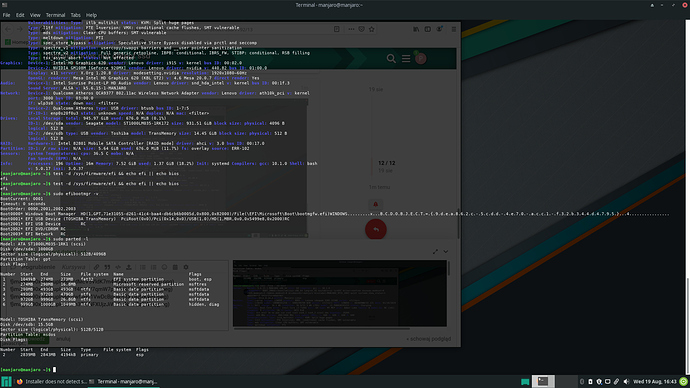Im trying to install manjaro on a new SSD but the installer does not detect it. What should I do?
first check that all disks are AHCI in Bios ( no raid no fast boot )
Welcome to the forum! ![]()
Please first read this very informative post below ─ we’ll wait until you’ve finished reading. ![]()
![]()
Then, as @stephane said, check your UEFI firmware settings and make sure your drives are set to AHCI, and that Secure Boot and Windows Fast Boot are disabled.
the drive on which I want to install the system has a different driver. how do i change it? (Disc model is Corsair mp510 240gb)
What do you mean by that? Hardware drivers are part of the kernel, normally ─ whether statically built-in or as loadable modules.
I mean the disk is not ahci.
Then what is it?
Again, please read this post below. The quality of our assistance is only ever going to be as good as the quality of the information you provide.
![]()
@Piotr534 I am assuming that you SSD is an M.2 drive since it is not ACHI. Some M.2 drives do not play well with Linux. My Western Digital Black and Samsung drives for example. The kernel will put them into a low power state. This means that they would not be recognized by the installer because they are not being powered on.
Try the following:
-
On the Grub screen that appears when you first boot to the USB drive. Highlight
Boot: Manjaro .x86_64and hit the E key. -
This will bring a text screen. Add the following to the line where you see
quiet. You can place it after the word quiet if you want.nvme_core.default_ps_max_latency_us=5500 -
Hit the F10 key to boot into the live session. Your SSD should now show up.
If that does not work, check to make sure that your SSD is properly installed into the M.2 slot.
Controller type is NVMe. (I heard it’s faster than ahci, do I need to change that?)
No, see my post above.
Unfortunately it doesn’t work for me. I checked that my drive is properly mounted. I have Windows 10 installed on another drive and it detected the second drive normally.
with USB iso manjaro live
open a terminal and reports
inxi -Fxza --no-host
test -d /sys/firmware/efi && echo efi || echo bios
sudo efibootmgr -v
sudo parted -lmissing
inxi -MCxPlease don’t use screenshots to post text output on the forum. Copy the text from the terminal window, then click the </> icon in the toolbar of the post editor, and paste the output of the command between the two lines that look like this. → ```
after typing inxi -MCx this is what i got Machine: Type: Laptop System: LENOVO product: 80X5 v: Lenovo ideapad 320S-15IKB serial: <root required> Mobo: LENOVO model: LNVNB161216 v: SDK0J40700 WIN serial: <root required> UEFI: LENOVO v: 4QCN49WW(V2.13) date: 01/10/2019 CPU: Topology: Dual Core model: Intel Core i3-7100U bits: 64 type: MT MCP arch: Amber Lake rev: 9 L2 cache: 3072 KiB flags: avx avx2 lm nx pae sse sse2 sse3 sse4_1 sse4_2 ssse3 vmx bogomips: 19204 Speed: 1252 MHz min/max: 400/2400 MHz Core speeds (MHz): 1: 1194 2: 1199 3: 1109 4: 1154
